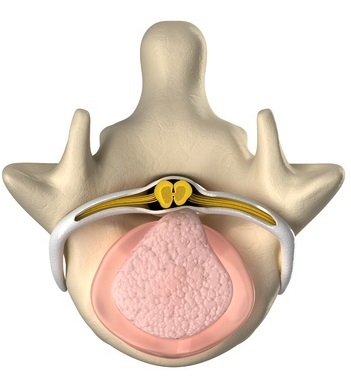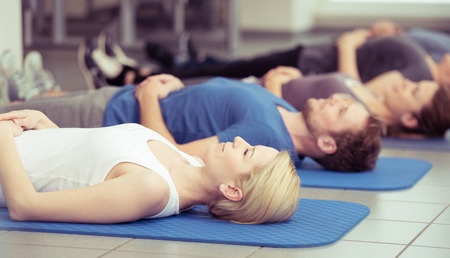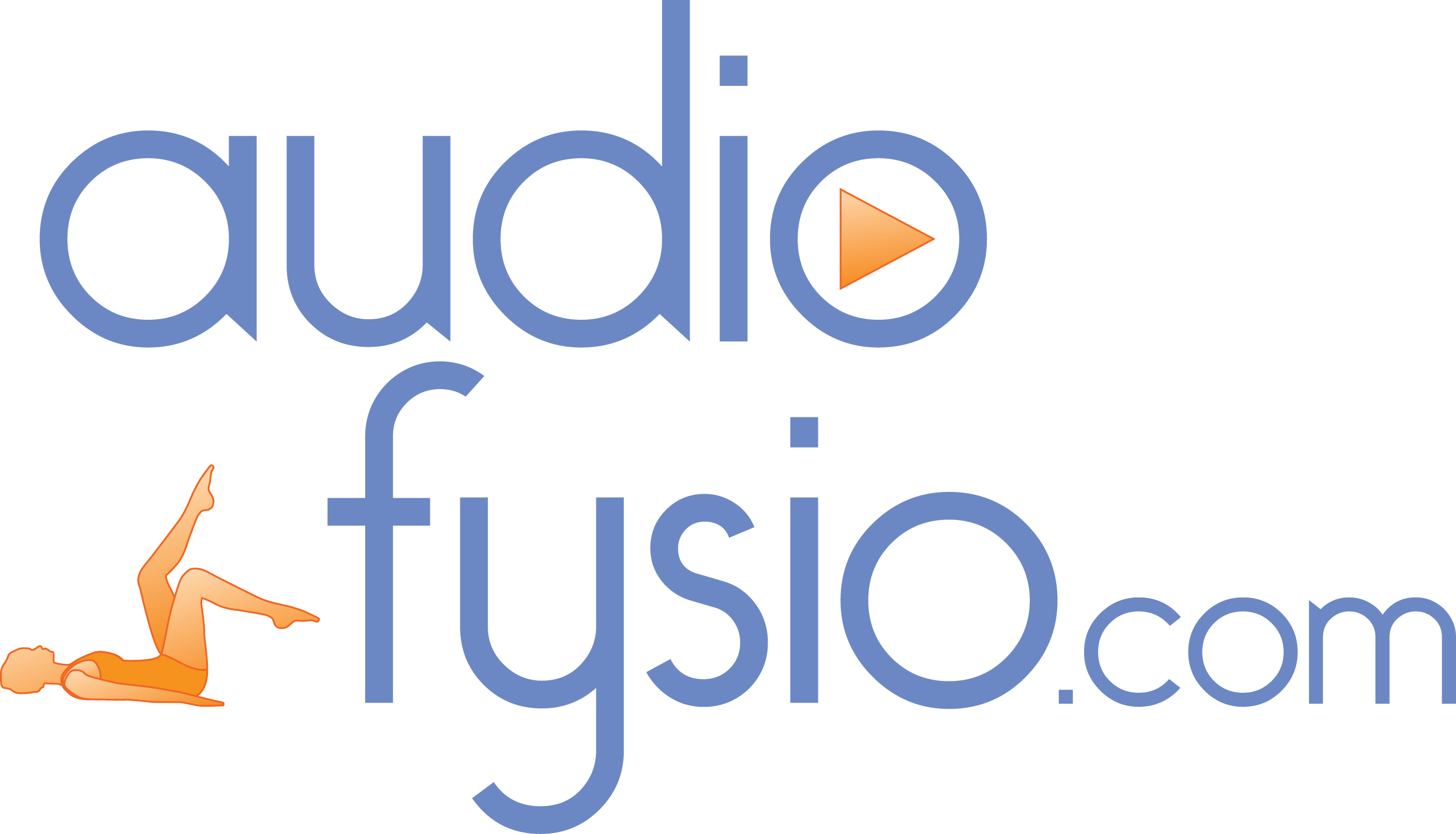What is a herniated disc?
A herniated disc is common. Especially people who put the wrong strain on their backs, have to deal with it. Here you can read more information about what a herniated disc is, the causes, symptoms, treatment and herniated disc exercises.
Your spine has several vertebrae. Between these vertebrae are intervertebral discs. An intervertebral disc is also called a discus. An intervertebral disc can be seen as a kind of shock absorber between two vertebrae in your spine. A herniated disc is a deviation from an intervertebral disc.
What happens to a herniated disc? The outer part of an intervertebral disc consists of connective tissue. Inside is a soft gelatinous fluid. This inner mass (nucleus pulposus) can bulge towards the outside of the intervertebral disc.

A herniated disc of the intervertebral disc.
Hernia nuclei pulposi
The contents of an intervertebral disc bulges beyond the intervertebral disc. This is usually done at the back. The hernia then presses on the content of your vertebral canal. More than 90% of the herniated discs occur in the lower back between the vertebrae L4 and L5 or L5 and S1.
Hernia causes
As you get older, the intervertebral disc wears out. This is often a cause of a herniated disc. A wrong posture is also a common cause. Because of our daily posture, the lower back gets the most to endure. Think for example of your own sitting position in the car, on the couch or at a desk. The most strain comes down to the lower part of your back.
Many people do not realise that they have a herniated disc. You don’t have to have any complaints about it. You notice it especially when the herniated disc presses on a nerve root. Usually this happens low in the back. A nerve root has nerves. The nerves make sure that signals go to and from the muscles. A herniated disc sometimes presses on this nerve root, so that you eventually feel a radiating pain in a leg.
Would you first like more insight about the damage in your back? In this book you can read how and why a herniated disc occurs in your back. With drawings and photographs you get a better picture of the causes. Highly recommended!
Low back pain radiation pain
In addition to low back pain, a herniated disc causes this pain to radiate to the leg. Sometimes this is called sciatica. The most common complaint of a hernia is back pain together with pain in a leg to below the knee. This is called a radicular syndrome. Besides the pain complaints you have neurological symptoms such as irritation, tingling or numbness.
If the pressure on the nerve root increases, numbness and loss of strength can occur in the area for which the nerve is responsible. The pain usually radiates from the lower back to the upper leg or the outside of the lower leg and foot. By coughing, sneezing and pressing the pressure on the nerve root increases, causing more pain.
Acute hernia
The diagnosis of a herniated disc is made by a general practitioner or neurologist. They will not immediately recommend surgery. Most symptoms of a herniated disc decrease or disappear after a few weeks. If the pain does not diminish, surgery may be necessary in some cases. In case of increasing symptoms or the occurrence of other serious symptoms, it is advisable to contact your doctor.
Hernia exercises
Exercises are usually useful after the most severe pain has passed. You may be afraid to move because of the pain. This can cause back pain to persist. Resting in bed is also not a sensible treatment. In the old days, the advice was quickly to keep bed rest. However, this advice is outdated. Because of a long rest period your condition and the size of your muscles decrease.

The Dutch General Practitioners Association advises in its guideline to stay in motion and to continue the daily activities as far as the complaints allow. On the basis of your symptoms (fatigue, pain in the lower back or leg) you can exercise and move. There should not be an increase in pain in any exercise. You may feel a slight pulling sensation in your back.
You have come to this website. So you want to do something about your back pain. Then I assume that you also want to get acquainted with a few first exercises!
Hernia L5 S1 exercises
Between two vertebrae is an intervertebral disc. A hernia causes damage to this intervertebral disc. A herniated disc often occurs at the level L5-S1. These are two vertebrae in the lower back. The L stands for the lumbar vertebrae. You have five. L1 to L5. L5 is the lower vertebra of the five. The lumbar vertebrae are transferred to the sacral vertebrae. These vertebrae begin with the S. S1 is the upper vertebra of the sacral vertebrae.
There is an intervertebral disc between vertebra L5 and vertebra S1. A herniated disc on L5-S1 means that the intervertebral disc between the lower lumbar vertebra L5 and the upper sacral vertebra S1 is damaged. A hernia can repair itself. A surgery is usually not immediately necessary. You can do the exercises calmly within your own pain threshold.
Hernia L4 L5 exercises
The lumbar vertebrae L4 and L5 are located at the bottom of your back. There is also an intervertebral disc between vertebra L4 and L5. If this disc is damaged we speak of a herniated disc at level L4-L5. Also then exercises can help you and usually a surgery is not immediately necessary.
If you know that the nerve pain comes from a bulging intervertebral disc, you can start treatment. Before you start a treatment, read enough information about a herniated disc. It is important that you understand what it is.
There is a good chance of natural recovery. Read more about which exercises can help you below or start right away with Bella’s Lower Back Pain App!
An exercise for example
In the practice program of Bella you will find many herniated disc exercises. One exercise you can perform is the following:
Lie on your back on your exercise mat. Continue breathing quietly. As you breathe out, pull your knee around a knee straight ahead towards your chest. The right knee towards your right shoulder and then the left knee towards your left shoulder. Hold your knee for a few seconds at a time.
The next step…
Now that you are on the website, are reading this information and have seen a first exercise, go on to the next step. And that’s good because you discover more about the influence of your own exercise program on your back.
To a healthy back!
Recovery after hernia surgery
Please note that you have not fully recovered after a stay in the hospital. After a surgery you sometimes have complaints that you still know from before the surgery. The pressure on the nerve may have disappeared, but the nerve needs time to recover. These complaints can be reduced by doing herniated disc exercises. Usually you will also be given a number of rules of life and exercises at home when you leave the hospital.


